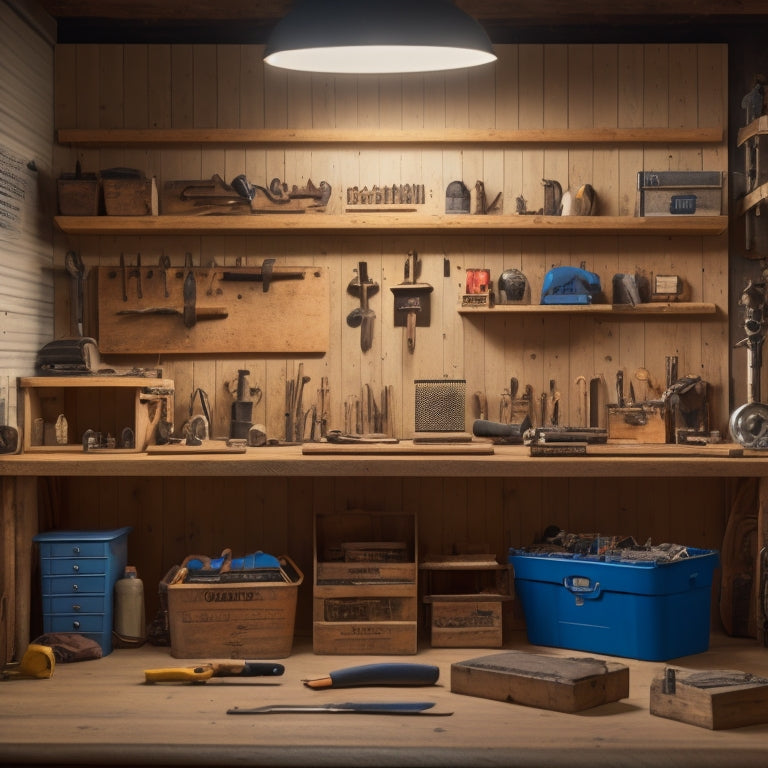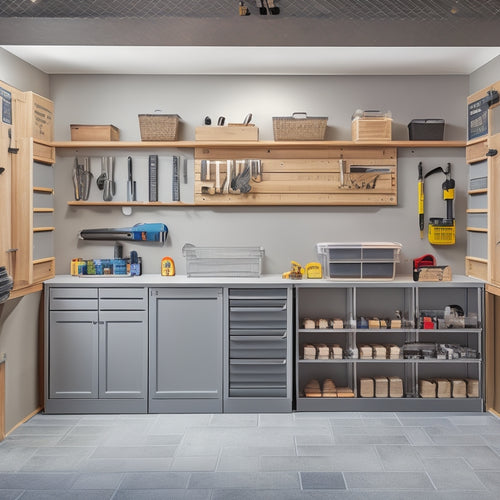
5 Essential Tool Organization Strategies for DIYers
Share
You'll transform your workshop into a productive space by implementing these five essential tool organization strategies. First, assign a home for each tool, categorizing them into groups and designating specific storage solutions. Next, maximize your vertical storage space by installing shelves, hooks, or pegboards to keep less frequently used items off the floor. Label and categorize your tools by type or project, and design a tool flow system that groups frequently used tools together. Store heavy tools below waist level to reduce lifting and bending, and get ready to streamline your DIY projects and boost productivity - there's more to discover to take your workshop to the next level.
Key Takeaways
• Assign a home for each tool, categorizing them into groups and designating specific storage solutions to maintain organization and efficiency.
• Utilize vertical storage space by installing shelves, hooks, or pegboards to keep less frequently used items off the floor and maximize storage capacity.
• Implement a labeling system, categorizing tools by type or project, and label toolboxes, bins, or containers to optimize storage space and tool retrieval.
• Design a tool flow system, grouping tools used most frequently together and placing them in the order they're typically used to streamline workflow and maintenance.
• Store heavy tools below waist level, minimizing lifting and bending, and utilize wall hooks, ceiling racks, or magnetic strips for lighter tools to reduce strain and injury.
Assign a Home for Each Tool
Assign a designated place for each tool in your workshop or storage area, making it easier to find what you need when you need it. This is the foundation of effective tool organization, and it's essential for maximizing workspace efficiency.
By designating a specific place for each tool, you'll avoid clutter and reduce the time spent searching for misplaced items. Start by categorizing your tools into groups, such as hand tools, power tools, and fasteners. Then, assign a specific storage solution for each group, like bins, baskets, or hooks.
Consider the frequency of use and store your most-used tools in easy-to-reach locations. Implement a 'first in, first out' system for consumables like sandpaper and drill bits to make sure you're always using the freshest supplies.
Utilize Vertical Storage Space
Utilize Vertical Storage Space
As you've assigned a home for each tool, you'll want to make the most of your workshop's vertical space by installing shelves, hooks, or a pegboard to keep less frequently used items off the floor and out of the way. This will help you maximize your workshop's storage capacity and keep your workspace clutter-free.
Here are some ideas for utilizing vertical storage space:
| Storage Solution | Benefits |
|---|---|
| Wall Hooks | Hang items like bikes, ladders, or cords, keeping them organized and easy to access |
| Pegboards | Customize your storage by hanging bins, baskets, or tools, and easily switch them out as needed |
| Hanging Baskets | Store items like nuts, bolts, or small parts, and label them for easy identification |
| Shelves | Store less frequently used items, like seasonal decorations or infrequently used tools, out of the way |
Label and Categorize Tools
Once you've optimized your workshop's vertical storage space, creating a labeling system is essential in categorizing your tools by type, frequency of use, or project, ensuring you can quickly locate and retrieve the right tool when you need it. This step is critical in tool identification, as it helps you distinguish between similar-looking tools and storage solutions.
For instance, labeling your toolboxes, bins, or containers with their contents can save you time and frustration when searching for a specific tool.
When organizing small tools, consider grouping them by category, such as hand tools, power tools, or specialty tools. This categorization will make it easier to find what you need and prevent clutter from building up in your workshop layout.
You can also label your tools according to the projects they're used for, making it simpler to prepare for upcoming tasks. By implementing a labeling system, you'll be able to maintain a well-organized workshop, reduce tool misplacement, and increase your productivity.
Implement a Tool Flow System
By designing a tool flow system, you can create a logical sequence of tool placement and retrieval, allowing you to work more efficiently and effectively in your workshop. This system ensures that tools are easily accessible when needed, reducing downtime and increasing productivity.
To implement a tool flow system, start by identifying the tools you use most frequently and grouping them together. Next, determine the workflow of your projects and place tools in the order they're typically used. This will prevent you from having to constantly search for tools, reducing frustration and increasing tool safety.
A well-designed tool flow system also makes tool maintenance and tracking easier, as you can quickly identify which tools need cleaning or replacement. Additionally, it helps you keep track of your tool inventory, making it simpler to order new tools or supplies as needed.
Store Heavy Tools Below Waist
Store Heavy Tools Below Waist
Place your heaviest tools, like table saws and drill presses, on lower shelves or in cabinets to minimize lifting and bending, reducing the risk of strain and injury. This simple strategy can save you from a world of pain and discomfort. By storing heavy tools at a comfortable height, you'll avoid straining your back and shoulders, allowing you to work more efficiently and safely.
For lighter tools and accessories, consider using wall hooks, ceiling racks, or magnetic strips to keep them organized and within easy reach. This will free up space on your workbench and reduce clutter.
You can also utilize rolling carts to store tools and supplies, making it easy to move them around your workspace as needed. By storing your tools thoughtfully, you'll be able to focus on the task at hand, rather than wasting time searching for misplaced items or struggling with heavy equipment.
Frequently Asked Questions
How Do I Keep Frequently Used Tools Easily Accessible?
"You're the master of your DIY domain, and your trusty tools are your right-hand men. Keep them within arm's reach with a sturdy tool belt or pegboard storage, ensuring you can whip out what you need in a flash."
Can I Use Repurposed Materials for DIY Tool Storage?
You can definitely repurpose materials for DIY tool storage, leveraging creative solutions and budget-friendly options. Upcycle old pallets, crates, or containers to create unique storage designs that not only save you money but also add a personal touch.
What Are Some Space-Saving Ideas for Small Garages?
"Imagine a medieval knight's armory in your small garage! You're on a quest for space-saving ideas. Install wall-mounted shelves and overhead storage for maximum capacity. Utilize portable tool chests and pegboard systems to keep tools within reach, making your DIY endeavors a breeze."
How Can I Prevent Tool Rust and Corrosion in Storage?
When storing tools, you'll want to prevent rust and corrosion by using silica packets or dehumidifiers to control moisture, and applying rust prevention coatings or oiling techniques to protect metal surfaces.
Are There Any Ergonomic Considerations for Tool Storage Layouts?
Will you fall victim to a DIY workspace that sacrifices comfort for convenience? Consider tool storage ergonomics to boost efficiency and reduce fatigue - it's time to design a layout that works with, not against, your body.
Related Posts
-

Small Shelving Options for Tight Spaces
You're surrounded by tight spaces in your home, and you need clever shelving solutions that optimize storage without ...
-

Essential Steps for Garage Storage System Design
You're about to change your cluttered garage into an organized haven by following a structured approach to garage sto...
-

What Size Rolling Storage Bin Do I Need
To determine the ideal size of your rolling storage bin, you'll need to measure your storage space accurately, consid...


